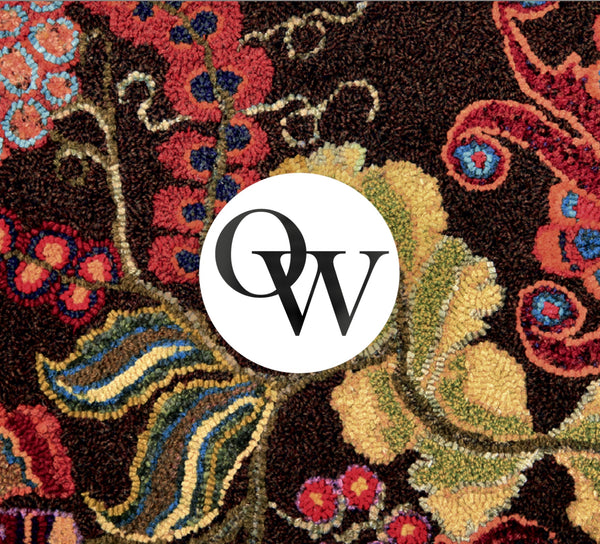
Thread to Art: How Warp & Weft a Design, Quality Weaver's Cloth, and Pattern Transfer Tips- Issue Four
Thread to Art: Issue #4
Why the Finished Size Changes in Punch Needle: Understanding the Warp and Weft in Weaver's Cloth, Pattern Transfer Tips, What Quality Weaver's Cloth Fabric Is, and Why It's Essential.
If you've ever noticed that the shape of your completed punch needle design changes more in one direction than another, you're not alone! One of the most important things to understand when tracing a punch needle embroidery pattern onto your weaver's cloth is how and why the finished size changes.
In fabric, the weave consists of two components—specifically the Warp and Weft—and their direction affects the size and shape of the finished design once the thread is incorporated.
The photograph above is a great example: it shows the exact size pattern, but the finished designs are different shapes — why?
The first design was drawn with the Weft running from top to bottom and the Warp side to side. It resulted in a finished piece that turned out taller and narrower.
The second pattern was drawn with the Weft running side to side and the warp top to bottom. This resulted in a finished piece that was wider and shorter than the first pattern.
Although both patterns were drawn straight don't o the fabric, the direction of the warp and weft caused the design to expand and contract in different ways.
Let's break it down so you can confidently transfer your patterns and avoid size surprises.
Warp & Weft?
The Weaver's Cloth fabric used for designs grows in the direction of the Weft (the stretch), and shrinks slightly in the direction of the Warp (non-stretch). This means the way your fabric is oriented before you begin drawing can have a noticeable impact on the finished piece.
- Warp = the threads that run the length of the fabric (usually no stretch)

- Weft = the threads that run across the fabric (usually has some stretch)

Why This Matters in a Punch Needle Project
If you're creating a set of Punch Needle designs that need to match in size, such as coordinating framed pairs, it's essential to position your fabric consistently with the Warp and Weft going in the same direction for each pattern. This ensures that both designs expand and contract uniformly, finishing at the same size.
What is Quality Weaver's Cloth Fabric?
Weaver's cloth fabric is the most common fabric used in Punch Needle Embroidery due to its unique blend: 55% polyester and 45% Cotton.
This combination allows:
- The fabric expands when punched and holds the thread securely when the needle is pulled out.
- The polyester portion is essential to provide this flexibility without tearing or breaking the weave.
- This fabric is durable and forgiving, even when you need to pull out loops and repeat the punching process.
I always recommend checking for the correct blend of the "weaver's cloth" before purchasing it, as some fabrics labeled as "weaver's cloth" may not contain the expected cotton/polyester blend. A lack of this fabric blend can affect the outcome of your finished design and be quite frustrating during the design creation process.
Pattern Transfer Tips
When transferring a pattern onto the weaver's cloth:
- Always align your design straight with the fabric grain, not at an angle.
- Use a lightbox and a Micron 05 black pen; it doesn't bleed like a Sharpie.
- The fine tip helps maintain the detail of your design.
- Both tools are affordable, reliable, and readily available online.
- When drawing a set of patterns, be aware of your warp and weft directions and ensure they are both drawn in the same direction.
Final Thoughts: How to Prevent Surprises
To recap:
- Your finished punch needle design will grow in the Weft direction and shrink slightly in the Warp direction.
- Be mindful of fabric orientation when drawing and transferring your pattern.
- For consistent sizing across multiple pieces, make sure the Warp and Weft run in the same direction for each pattern.
- Choose your layout depending on whether you prefer the design to finish taller or wider. With this knowledge, you'll have more control over the outcome—and fewer surprises—on your creative punch needle journey.
Copyright © 2025 By Kelly Kanyok – All Rights Reserved

